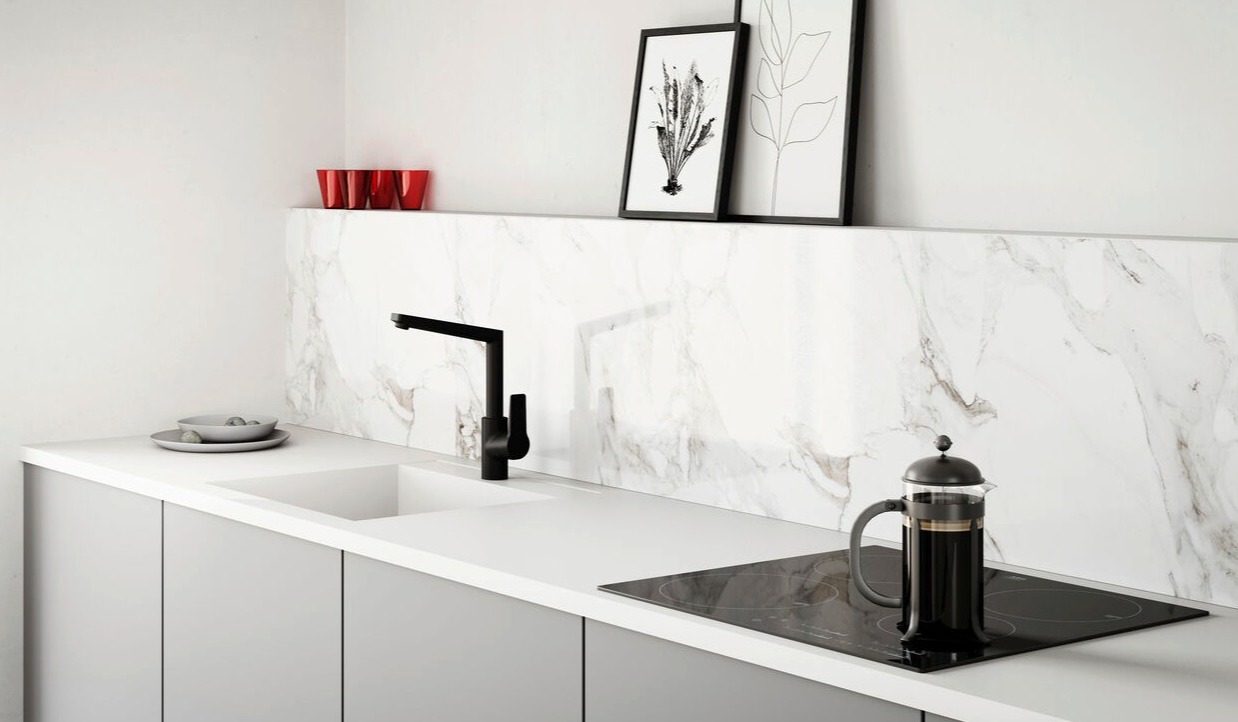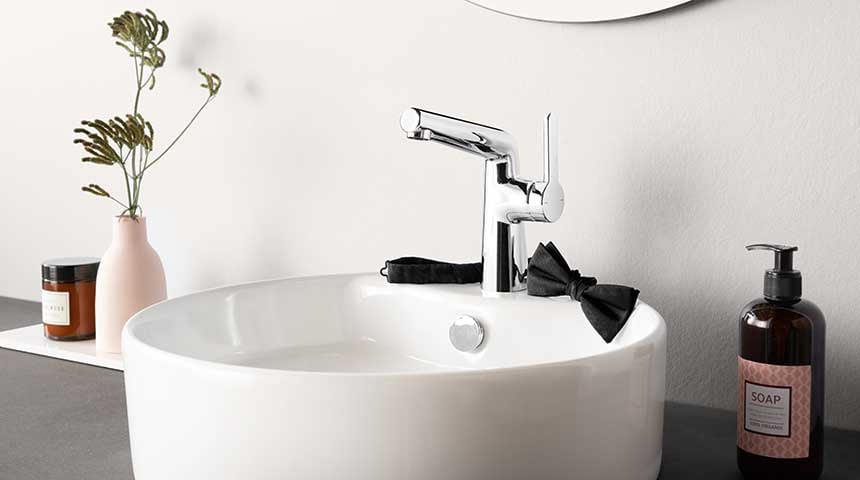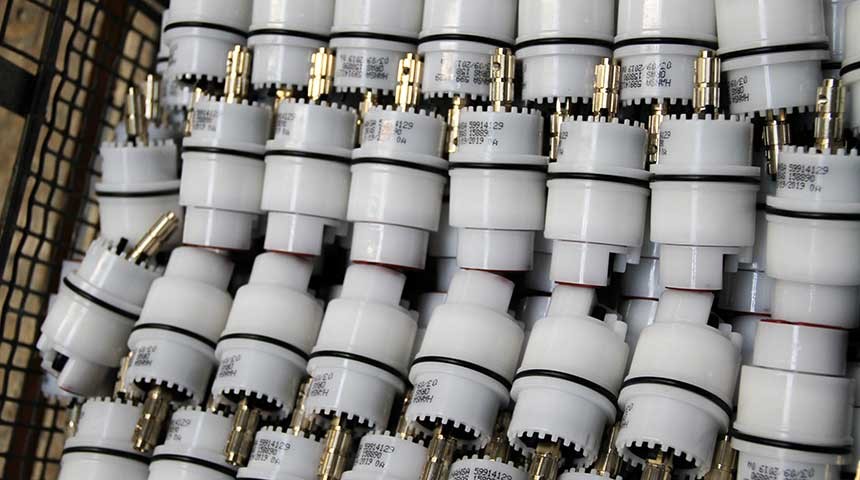Whether it’s about upgrading your kitchen faucet for more advanced functionality or replacing your existing bathroom faucet with a more durable model, choosing the right faucet at the right price can be challenging.
High quality, reliability, durability and recommendations from professionals, family and friends are the main drivers for choosing a faucet.
But even when taking all these factors into account, at the end of the day, we’re left with the final call on price.
As you’re trying to navigate through a wide range of price categories, here’s what to keep in mind to understand the price difference.

Black HANSATWIST kitchen faucet with ceramic coating in a white kitchen.
Why the price difference in faucets?
Once you start researching, you’ll notice that there can be huge price differences between faucet types.
Whether you’re looking for a low-budget fixture, mid-range or premium faucet, the price can be driven by many variables, such as body material, special technology and features, and the finishing coating of the faucet.
Knowing about the quality differences of the materials and finishes is key to finding the right faucet for your budget. But it’s also about understanding the steps included in the product development and production process as well as ensuring the availability of spare parts for your faucet to ensure long-lasting quality.
Here’s what determines the price of faucets.
The value of product development and testing
Planning and designing high-quality products usually takes time. From designing to simulating production on a computer to its final casting, the development of a new faucet usually undergoes multiple rounds of testing and adjustments until it's perfected.
This requires valuable resources and time spent on research and development, product optimisation, testing technology and final quality control.

The design and development of the faucet is a crucial and time-consuming step to ensure quality and durability of a faucet.
Here are the two major planning and testing processes that are decisive for guaranteeing a smoothly running and trouble-free kitchen and bathroom faucet
- Design and development: During the design process, several regulations and standards have to be met, which are critical for the faucet’s later performance. As such, a large share of research and development is dedicated to lowering the sound level of the faucet – making up one of the most noticeable differences between low-budget and high-quality faucets.
At HANSA, we, for example, specialise in guaranteeing the lowest noise class for faucets, testing its sound level in a separate laboratory made of a floating concrete room.
For more unique product lines, price can also be influenced by the careful design, manual processing and material choice of the faucet.
- Assembly and quality control: When it comes to the assembly and final quality check, each faucet must be treated differently depending on its components and functions.
Special components and electronics, which are processed in more advanced water fixtures, are installed inside the faucet during assembly and often assembled by hand. As a final step, careful inspection and quality control are conducted manually to ensure high-quality functionality in every product.
The value of internal components

HANSA cartridges are made of high quality and durable materials to ensure long life-time.
Apart from resources spent on the development, production and quality assurance, the choice of material also plays a critical role – especially when it comes to the inner components of your faucet, such as the cartridge.
Referred to as the soul of the faucet, regulating water flow and temperature, cartridge is a critical component for providing you with the right amount of water at the desired temperature. To ensure high quality and a long, hassle-free lifetime, all our main volume faucets are equipped with cartridges that are produced in-house.
Using ceramic disk valves made from aluminium oxide, the third hardest substance in the world, makes HANSA cartridges extremely durable. Alternatives, such as metal-based cartridges, ball or compression valves, may come at a lower price but are also more susceptible to leakages.
It’s not only high-quality inner components, but also the availability of spare parts that are decisive to prolong the lifetime of the faucet (to up to 20 years) and minimise costs spent on maintenance in the long run.
That’s why, before choosing a faucet, always pay close attention to the technology, materials used and availability of spare parts.
The value of the right body and finish
Lastly, price can vary depending on the body material and finishing coating of your faucet.
Body material
Most faucet bodies are made of brass or stainless steel, which are nickel-plated before receiving a finishing coating.
- Brass: Brass can be a reliable, middle-range choice as it’s extremely resistant to corrosion and leakages.
- Stainless steel: Stainless steel bodies are commonly used for mid-range to high range faucets and usually come at a higher price.
Finishing coating
Another factor determining the price of faucet is its final coating. As the most common finishes, chrome-plated or polished brass are both highly durable and come at a reasonable price.
Brushed nickel can easily move you up the price ladder. With a soft metallic look, it’s one of the most durable finishes, and particularly resistant to fingerprints and water spots.
Ceramic coatings, such as matt black coatings, are the newest design trend and suitable for a more luxurious feel. But they also come with a price, going through a thorough 5-step coating process for a more durable finish. You can find out more about black-coated faucets here.
Whether you’re going for advanced or basic options, it’s never a bad idea to understand the variables determining the price difference in your faucet choice to take an informed decision.
As you’re navigating through the different price categories, checking for reliable production, quality management and long-lasting functionality can help you get the quality you need.

-block-desktop-860x480.jpg?width=940&name=40210_Hansa_Vantis_Style_Basin01_Hansa_Vari_oh_IR.tif(1)-block-desktop-860x480.jpg)

-block-desktop-860x480%20(1).jpg?width=940&name=Oras_Romantic_V3.jpg(1)-block-desktop-860x480%20(1).jpg)



